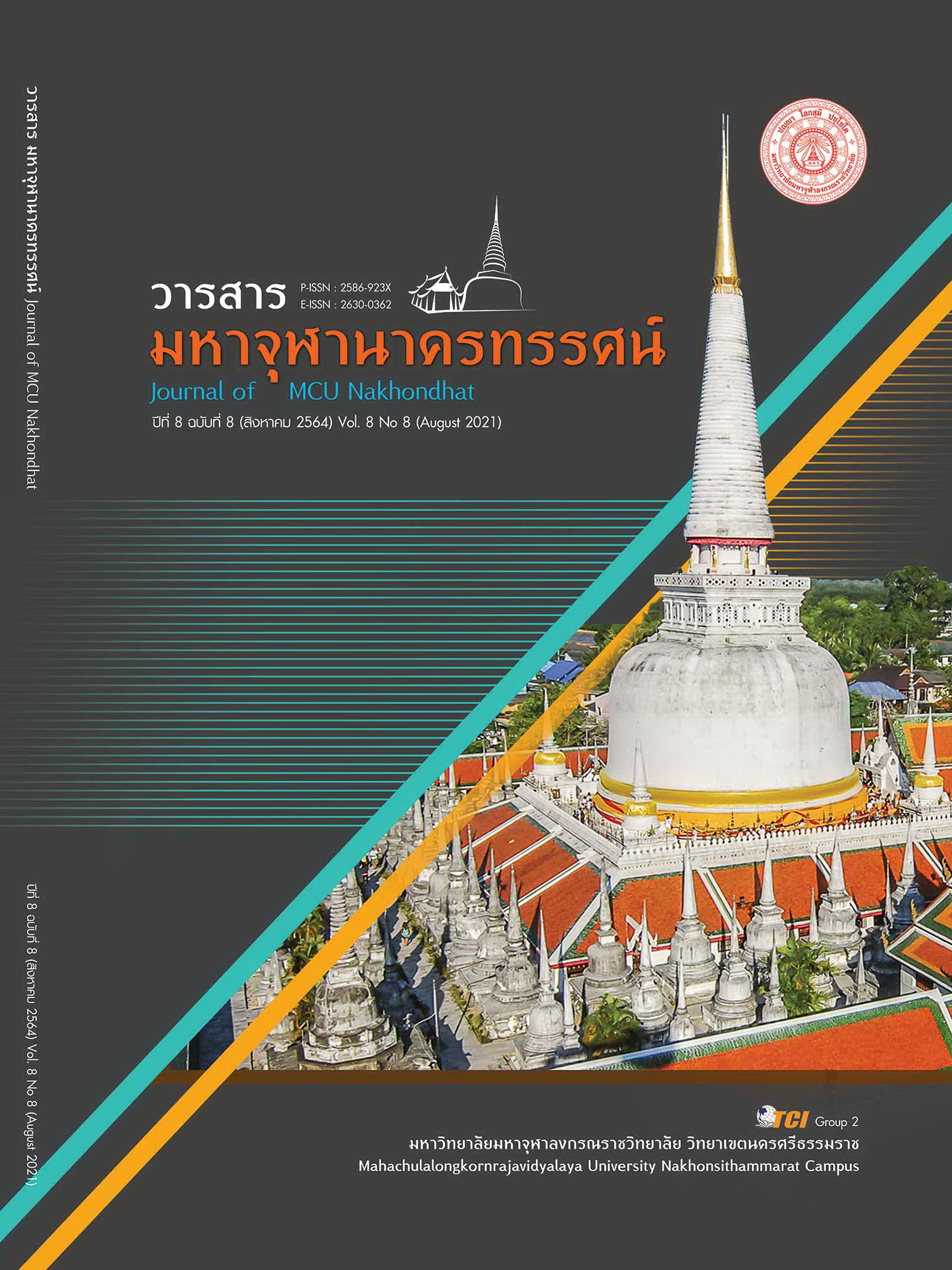ADMINISTRATIVE BEHAVIOR OF ADMINISTRATORS AFFECTING THE USE OF EDUCATION INFORMATION TECHNOLOGY IN BASIC EDUCATION OF THE SECONDARY EDUCATIONAL SERVICE AREA OFFICE 12
Main Article Content
Abstract
The objectives of this research article wer: 1) study administrative behaviors of administrators in educational institutions; 2) study the use of information technology in education in educational institutions; 3) study administrative behaviors of administrators that affect the use of technology. Educational informatics in basic education institutions Use a quantitative research methodology. The sample group used in this research including the director of the school Deputy director of the school or teachers who act as deputy director of the school and teachers, the secondary educational service area office 12, a total of 165 people using the ready-made tables of Crazy Morgan the research tool was a questionnaire. The Conformity Index for each item was 0.91 and the confidence value for the whole issue was 0.97. The statistics used in the data analysis were frequency, percentage, mean, standard deviation. Pearson correlation coefficient and multiple regression. The results found that 1) Administrative behavior of administrators in educational institutions Overall, it is at a high level. When considering each aspect, it was found that the aspect of motivation was at the highest level. decision-making communication and the leadership aspect was at a high level, respectively. 2) The level of educational information technology uses in basic education institutions. Overall, it is at the highest level. When considering item by item, it was found that executives had basic skills and knowledge in information technology. with the highest average, followed by executives promoting personnel to be knowledgeable about information technology. and educational institutions personnel can use information technology to perform their duties 3) The administrative behavior of administrators affecting the use of educational information technology in basic education institutions consisted of 2 aspects: motivation and decision-making. The multiple correlation coefficient was 0.568. The predictive efficiency was 31.70 percent with statistical significance at the .01 level.
Article Details
References
กัญญาภัค แม๊คมานัส. (2558). การพัฒนาตัวชี้วัดสมรรถนะของผู้ช่วยพยาบาล โรงเรียนผู้ช่วยพยาบาล คณะแพทยศาสตร์ศิริราชพยาบาลมหาวิทยาลัยมหิดล. นนทบุรี: มหาวิทยาลัยสุโขทัยธรรมาธิราช.
ธร สุนทรายุทธ. (2550). การบริหารความเสี่ยงทางการศึกษา. กรุงเทพมหานคร: เนติกุลการพิมพ์.
เนตร์พัณณา ยาวิราช. (2552). ภาวะผู้นำและผู้นำเชิงกลยุทธ์. กรุงเทพมหานคร: บริษัท ทริปเพิ้ลกรุ้ป จำกัด.
ปัทมพร วงศ์เณร. (2555). พฤติกรรมการบริหารของผู้บริหารสถานศึกษาที่ส่งผลต่อกระบวนการนิเทศภายในสถานศึกษา สังกัดสำนักงานเขตพื้นที่การศึกษาประถมศึกษาประจวบคีรีขันธ์ เขต 1. ใน วิทยานิพนธ์ครุศาสตรมหาบัณฑิต สาขาวิชาการบริหารการศึกษา. มหาวิทยาลัยราชภัฏเพชรบุรี.
ปิยะ หมานอีน. (2562). บทบาทของผู้บริหารในการเสริมสร้างแรงจูงใจในการปฏิบัติงานของครูศูนย์อบรมศาสนาอิสลามและจริยธรรมประจำมัสยิด จังหวัดนครศรีธรรมราช. ใน วิทยานิพนธ์ปริญญาศึกษาศาสตรมหาบัณฑิต สาขาวิชาการบริหารการศึกษา. มหาวิทยาลัยหาดใหญ่.
มหาวิทยาลัยราชภัฏนครศรีธรรมราช. (2564). หนังสือขอความอนุเคราห์ตอบแบบสอบถาม. นครศรีธรรมราช: มหาวิทยาลัยราชภัฏนครศรีธรรมราช.
วิเชียร วิทยอุดม. (2550). การพัฒนาองค์การ. กรุงเทพมหานคร: บริษัท ธนวัชการพิมพ์จากัด.
ศันสนีย์ พรมพินิจ. (2559). ความสัมพันธ์ระหว่างบทบาทของผู้บริหารโรงเรียนในการส่งเสริมการใช้เทคโนโลยีสารสนเทศและการสื่อสารเพื่อการศึกษากับประสิทธิผลของโรงเรียนโพธิสัมพันธ์พิทยาคารสังกัดสำนักงานเขตพื้นที่การศึกษามัธยมศึกษา เขต 18. ใน วิทยานิพนธ์ครุศาสตรมหาบัณฑิต สาขาการศึกษามหาบัณฑิต. มหาวิทยาลัยบูรพา.
ศิริวรรณ เสรีรัตน์. (2561). การบริหารเชิงกลยุทธ์. กรุงเทพมหานคร: พัฒนศึกษา.
ศูนย์เทคโนโลยีสารสนเทศและการสื่อสาร สำนักงานเขตพื้นที่การศึกษามัธยมศึกษา เขต 12. (2559). แผนยุทธศาสตร์เทคโนโลยีสารสนเทศและการสื่อสาร. นครศรีธรรมราช: สำนักงานเขตพื้นที่การศึกษามัธยมศึกษา เขต 12.
สมจิตร เจริญกร. (2561). ภาวะผู้นำทางวิชาการของผู้บริหารสถานศึกษาในองค์กร. Journal of Roi Kaensarn Academi, 3(2), 1-16.
สำนักงานคณะกรรมการพัฒนาการเศรษฐกิจและสังคมแห่งชาติ. (2559). การพัฒนาเศรษฐกิจและสังคม. กรุงเทพมหานคร: สำนักงานคณะกรรมการพัฒนาการเศรษฐกิจและสังคมแห่งชาติ.
Beach. (1967). Personnel Mangement People at Work. New York: Book.
Christopher. (2005). Relationship Marketing: Bringing Quality, Customer Service and Marketing Together. Oxford: Butterworth Heinemann.
Douglas McGregor. (1960). Extraordinary Leadership in education: Tranformational andtransactional leadership as predictor of effectiveness. Dissertation abstracts international, 75(3), 157-158.
Gurr. (2000). The Impact of Information and Communication Technologieson Informal Scholarly Scientific Communication: A Literature Review. Retrieved March 24, 2021, from http://www. glue.umd.edu/~cpikas/878/Pikas_The_Impact_oLlCTs _oLISS C:0506.pdf.
Krejcie, R. V. & Morgan, D. W. (1970). Determining Sample Size for Research Activities. Educational and Psychological Measurement, 30(3), 607-610.
Rodriguez. (2017). Relation between social-environmental responsibility and performance in hotel firms. Hospitality Management, 26(4), 824-839.


